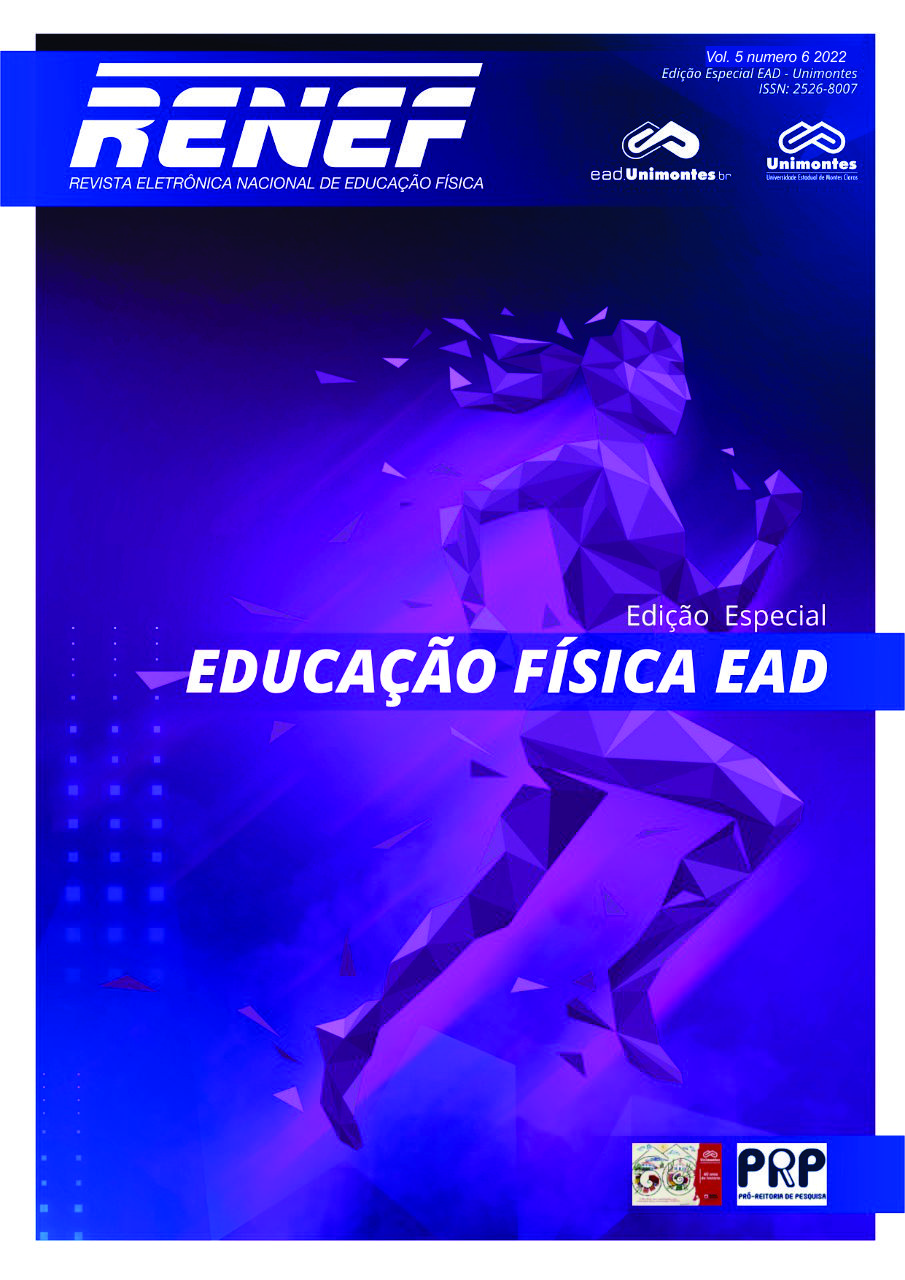CHILD SEDENTARISM CAUSED BY THE EXCESSIVE USE OF TECHNOLOGY
Keywords:
Sedentary lifestyle. Technology. Elementary School I. School Physical Education. Kids.Abstract
Children's sedentary lifestyle has been increasing in Brazil due to the use of technologies, and with the increase of street violence, many parents do not let their children go out to play. Objective: To evaluate the use of technologies in the lives of children from Elementary School I Initial Years of the State public school system. Methodology: A descriptive cross-sectional research was carried out to collect quantitative data in order to prove children's sedentary lifestyle institutions of the state public education network in the city of Monte Azul – MG. Result: When approaching the child sedentary issue caused by the excessive use of technology, it was noticed that 54% of the students never leave the tasks for later to be using the technologies; 56% of students never prefer the emotion of technologies; 54% of students answered that people sometimes complain about the time they spend online; the school grades of 72% of students were never affected by the use of technology; 60% of students never feel moody, depressed or nervous when they are offline. Conclusion: Taking into account the results obtained on the excessive use of technology and how much technology has helped us to evolve, it was found that most students surveyed do not spend much time connected to technology and prefer the pleasure of hanging out with other people and practicing activities physical, as they are aware that uncontrolled use of existing technologies can bring some damage to physical and mental health.
Downloads
References
BERNS, R. Topical Child Development. 2002. Disponível em: http://104.238.222.167/berns-roberta-m-child-family-school.pdf. Acesso em: 27 dez. 2021.
BORBA, A. Ensino fundamental de nove anos: orientações para inclusão da criança de seis anos de idade. 2007. Disponível em: http://portal.mec.gov.br/seb/arquivos/pdf/Ensfund/ensifund9anobasefinal.pdf. Acesso em: 15 out. 2021.
BRAND, J; RENNER, R. Estabelecendo fronteiras e limites: algumas orientações. Disponível em: http://www.avgdigitaldiaries.com/post/6874407117/setting-boundaries-and-limits-some-guidlines-on. Acesso em: 24 out. 2021.
COVALESK, R. L.; SIQUEIRA, O. A. S. Conteúdo de marca audiovisual e regimes interacionais: Reflexões sobre o engajamento digital do consumidor. Intercom-RBCC. São Paulo. v.40. n.2. p.61-75. Maio/agosto. 2017.
DARIDO, S. C. Educação Física na escola: questões e reflexões. Rio de Janeiro: Guanabara. Koogan, 2003.
GUALANO, B; TINUCCI, T. Sedentarismo, exercício físico e doenças crônicas. Revista Brasileira de Educação Física e Esporte. São Paulo. v. 25, p. 37-43, dez. 2011.
GUEDES, N. P. A influência da tecnologia para o sedentarismo de estudantes no ensino fundamental. Brasília 2015. Disponível em: https://repositorio.uniceub.br/jspui/bitstream/235/7546/1/21313015.pdf>. Acesso em: 18 out. 2021.
MACHADO, C. M. O uso da tecnologia como meio de favorecer saúde, qualidade de vida e a educação. Goiás, p. 6, dez. 2018.
MAZIERO, L. L.; RIBEIRO, D. F.; REIS, H. M. Desenvolvimento infantil e tecnologia. Revista Interface Tecnológica v.13, n.1, p.79-91. 2016. Disponível em: https://revista.fatectq.edu.br/index.php/interfacetecnologica/article/view/127/110. Acesso em: 16 out. 2021.
MARQUES, S. M. O Lúdico: Jogos, Brinquedos e Brincadeiras na Construção do Processo de Aprendizagem na Educação Infantil. Monografia – 2012. Disponível em: https://pedagogiaaopedaletra.com/monografia-o-ludico-jogos-brinquedos-e-brincadeiras-na-construcao-do-processo-de-aprendizagem-na-educacao-infantil/. Acesso em: 24 out. 2021.
MONTEIRO, A. F.; OSÓRIO, A. J. Novas tecnologias, riscos e oportunidades na perspectiva das crianças. Revista Portuguesa de Educação. V.28. n.1. p.35-37. 2015.
MOURA, D. A. et al. Hábitos de lazer em escolares da cidade de Bocaiúva/MG, Brasil: um estudo de prevalência em crianças e adolescentes de escolas públicas e privadas. Psicologia.pt, 26/02/2017. Disponível em: encurtador.com.br/DNOT4. Acesso em: 29 maio 2021.
NIELSEN. American families see tablet as playmate teacher and babysitter. 2012. Disponível em: http://www.nielsen.com/us/en/insights/news/2012/american-families-see-tablets-as-playmate-teacher-and-babysitter.html. Acesso em 27 dez. 2021.
OLIVEIRA, E. S. A. Infância e cultura contemporânea: os diálogos das crianças com a mídia em contextos educativos. Dissertação (Mestrado em Educação) - UFMT/Rondonópolis, Mato Grosso, Brasil, 2014.
OLIVEIRA, E. S. A. Infância, mídia e Educação Física no contemporâneo: a influência dos heróis nas culturas lúdicas das crianças. Tese de Doutorado em Estudos da Criança (especialidade Educação Física e Saúde Infantil). Universidade do Minho, Braga, Portugal, 2020.
PAIVA, N. M. N; COSTA, J. S. A influência da tecnologia na infância: desenvolvimento ou ameaça? Portal dos psicólogos. ISSN 1646-6977. Jan.2015. Disponível em: http://www.psicologia.pt. Acesso em: 16 out. 2021.
RODRIGUES, W.C et al. Metodologia científica. São Paulo: Avercamp, v. 90, 2006.
SILVA, T. Os aspectos sociais, cognitivos e afetivos sobre a geração de adolescentes conectados às tecnologias digitais. Trabalho de conclusão de curso (graduação) UFP. João Pessoa. 2016.
SOUZA JUNIOR, S. L. P; BIER, A. A importância da atividade física na promoção de saúde da população infanto-juvenil. Revista digital Efdeportes. Buenos Aires. v.13, n. 119. Abr. 2008. Disponível em: http://www.efdeportes.com/. Acesso em: 19 out. 2021.
SOUZA, I. M. A; SOUZA, L. V. A. O uso da tecnologia como facilitadora da aprendizagem do aluno na escola. Itabaiana : GEPIADDE, Ano 4, V.8 jul-dez de 2010.
Published
Versions
- 2022-07-29 (5)
- 2022-07-29 (4)
- 2022-07-29 (3)
- 2022-06-29 (2)
- 2022-07-29 (1)





 English
English
 Español (España)
Español (España)
 Français (France)
Français (France)
 Português (Brasil)
Português (Brasil)

















